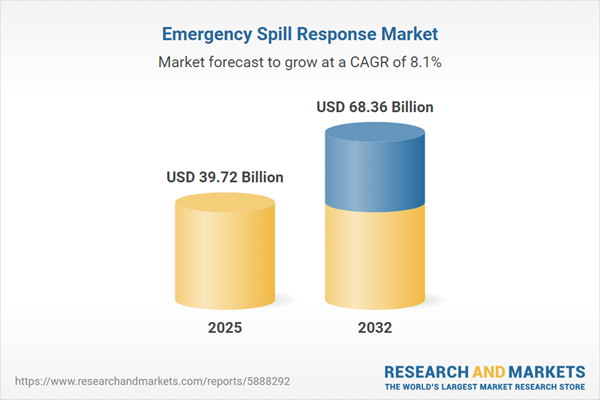Speak directly to the analyst to clarify any post sales queries you may have.
Emergency spill response has become integral to business continuity as evolving regulatory requirements, greater operational complexities, and increased attention to environmental responsibility prompt organizations to enhance risk management strategies.
Market Snapshot: Emergency Spill Response Market Size and Growth
The emergency spill response market is experiencing solid expansion, with projections indicating significant growth in valuation from 2024 to 2032 and a compound annual growth rate of 8.06%. Stricter regulatory oversight, rising industrial activity, and a persistent focus on minimizing business disruption are reinforcing demand for advanced response capabilities. Companies are prioritizing digital monitoring systems, automated response technology, and integrated supply chain management to uphold compliance and operational reliability. The increasingly dynamic operational landscape underlines the need for proactive, scalable solutions that help sustain uninterrupted business activity and support long-term resilience across sectors.
Scope & Segmentation: Comprehensive Industry Coverage
This in-depth report provides senior executives with targeted analysis to optimize strategic planning in the emergency spill response sector. Coverage spans advancements in response tools, evolving service delivery models, and emerging deployment methods to inform high-level decisions and procurement initiatives.
- Product Types: Includes absorbents made from both natural fibers and advanced synthetic materials, multiple boom solutions such as containment, foam, and inflatable versions, a range of dispersant options including biosurfactants and chemical agents, and oil recovery skimmers utilizing either oleophilic or weir-based mechanisms to address different incident profiles.
- Applications: Covers use cases in chemical and specialty manufacturing, petrochemical facilities, marine spill environments (offshore and inland waterways), municipal agencies managing stormwater or wastewater, and oil and gas operations situated both offshore and onshore.
- Service Types: Offers a spectrum of support from on-demand and contract-based cleanup services to consulting on risk assessments, workforce training, regular inspections, and maintenance designed for both routine and critical scenarios.
- Deployment Methods: Encompasses rapid on-site deployments (manual or automated), as well as remote monitoring via drone and satellite solutions to ensure timely, effective responses regardless of geographic or operational limitations.
- Regions Covered: Extends analysis across North America, Latin America, Europe, Middle East and Africa, and Asia-Pacific. The study addresses distinctions in compliance and operational priorities in key markets, including the United States, China, India, the UK, Germany, Brazil, South Africa, Australia, and Japan, accounting for regulatory variability and differences in end-user needs.
Key Takeaways: Strategic Insights for Decision-Makers
- Early integration of digital detection and containment solutions enables organizations to reduce environmental risk and accelerate response efficiency in high-stakes environments.
- Combining innovative spill response materials with improved logistics and up-to-date compliance policies elevates the reliability of preparedness frameworks across industries.
- Investments in staff training and stakeholder outreach contribute to confidence in emergency preparedness, reinforcing organizational reputation and response capabilities.
- Regional analysis reveals established markets focus on automating monitoring and response while developing regions prioritize scalable systems and qualified teams for sustainable operational risk management.
- Diversified research and development initiatives, paired with agile supply planning, support efficient deployment of technology upgrades and enhance operational consistency during unexpected events.
Tariff Impact on Supply Chains and Operations
Adjustments in U.S. tariff regulations are prompting organizations to re-evaluate sourcing strategies, shifting preference toward local suppliers for essential containment booms and sorbent products. This trend is boosting domestic manufacturing investments and encouraging modular assembly of oil recovery solutions, helping companies mitigate trade uncertainty and maintain operational continuity as regulatory environments change.
Methodology & Data Sources
This report uses a hybrid research methodology, blending direct interviews with industry experts, analysis of technical literature, up-to-date regulatory reviews, and scrutiny of key patents. Quantitative market data and qualitative insights are integrated to form a rounded view of industry direction.
Why This Report Matters
- Enables executives to identify and implement the most effective emergency spill response technologies aligned with organizational risk profiles and long-term compliance strategies.
- Provides a benchmarking resource for supplier comparison, supporting readiness for diverse regulatory environments and optimizing procurement effectiveness.
- Forms a foundation for scenario planning and risk mitigation, helping leaders direct investment and resources to meet operational objectives across multiple markets.
Conclusion
Strategic investments in emergency spill response are vital for regulatory alignment, business resilience, and responsible environmental stewardship. This report equips organizations to tackle emerging risks and secure their critical response capabilities proactively.
Additional Product Information:
- Purchase of this report includes 1 year online access with quarterly updates.
- This report can be updated on request. Please contact our Customer Experience team using the Ask a Question widget on our website.
Table of Contents
3. Executive Summary
4. Market Overview
7. Cumulative Impact of Artificial Intelligence 2025
Samples

LOADING...
Companies Mentioned
The key companies profiled in this Emergency Spill Response market report include:- Clean Harbors, Inc.
- Oil Spill Response Limited
- Wild Well Control, Inc.
- Resolve Marine Group, LLC
- Marine Pollution Control Corporation
- T&T Salvage, Inc.
- Marine Spill Response Corporation
- Global Diving & Salvage, LLC
- Helix Well Containment Group LLC
- Spill Tech Environmental Corp.
Table Information
| Report Attribute | Details |
|---|---|
| No. of Pages | 197 |
| Published | October 2025 |
| Forecast Period | 2025 - 2032 |
| Estimated Market Value ( USD | $ 39.72 Billion |
| Forecasted Market Value ( USD | $ 68.36 Billion |
| Compound Annual Growth Rate | 8.0% |
| Regions Covered | Global |
| No. of Companies Mentioned | 11 |









